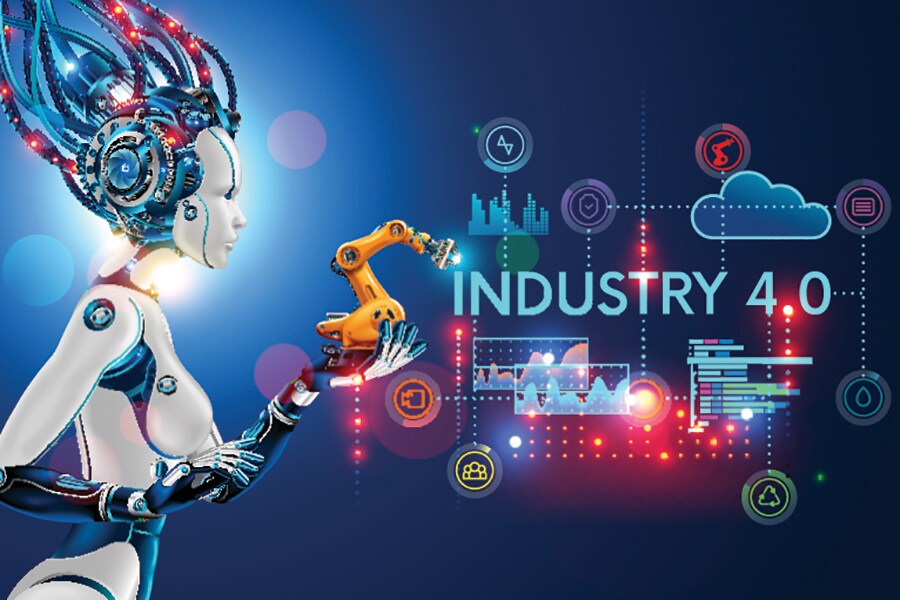The term Industry 4.0 first gained prominence during the 2011 Hanover Fair. Eventually, after much deliberation, the German Federal Ministry of Research and Education (BMBF) and the Ministry for Economic Affairs and Energy (BMWI) adopted it as a strategically important national initiative.
Industry 4.0 (I4) aims to enhance digitalization of industrial processes in small, medium, and large enterprises. The key objective is to integrate embedded computers, sensors, wireless networks, and real-world manufacturing systems and instrumentation (cyber-physical systems) to enable data- and information sharing within and outside of these systems. The resulting “smart factory" is capable of helping manufacturers significantly increase their output, ensure consistency, and get the most value from their machine and equipment. The physical systems, software solutions, and other smart factory parts generate a tidal wave of big data.
Manufacturers could take advantage of cheaper distributed data storage, powerful computing capacities, and advanced data analytics tools to perform meaningful analyses of large data sets. A deep and accurate understanding of big data can be successfully transferred to various facets of manufacturing, such as predictive maintenance, supply chain management, production defects reduction, quality control, occupational hazard identification, worker safety, and energy optimization.
In an age where manufacturers are challenged to increase production with fewer resources and get their finished products to market sooner, mature manufacturing systems envisioned by I4 promise to rev up production lines, help turn out goods faster, and crunch delivery times and cost. Not only is the production faster, computerized numerical control (CNC) machines as well as interchangeable tooling and mold options make it possible to flexibly assemble multiple products and models on the same production line. Flexible manufacturing processes will also enable mass customization. The result pairs the advantages of mass production viz low unit costs, with the one-to-one experience of personalization. Mass customization, considered a defining feature I4, will result in high-quality, built-to-order products, while ensuring reasonably high volumes and low cost.
Legacy manufacturers looking to move up the road towards I4 must embrace a range of software solutions in a timely manner in order to perform that transition successfully and stay competitive. There are various software building blocks which underpin the operations of digital enterprises.
- Hosting services
- Industrial IoT platforms
- Industrial analytics platforms
- Industrial cybersecurity solutions
- Cloud-based system integration, software development tools, machine vision software
- RFID and barcode scanning solutions
- Inventory transportation
- Additive manufacturing
- Augmented reality platforms
The drive toward digital manufacturing is a high-stakes game for both national economies and manufacturers. Stakeholders in manufacturing industries and policymakers alike acknowledge the need to further bolster the country’s credentials as an engineering nation (“the power of German engineering"). In Germany, nearly 10 million jobs were directly or indirectly linked to manufacturing (Destatis, “German labour market to Year 2010, 2019 and 2020") there is realization that it is important to improve the contribution of the sector in employment generation. This calls for putting more skin in the manufacturing game through continued investment in the smart technologies required to automate machines and processes. Against the above backdrop, one would reasonably expect the growing compulsion to digitalize to lift industrial software sales.
Our experiences during the coronavirus pandemic has shown us how manufacturing supply chains are sensitive to global disruptions. Industry 4.0 could help in not only optimizing manufacturing processes by producing more output with fewer resources, but by encouraging mass upskilling across the manufacturing labor market.
Before we celebrate…
Why is the I4 relevant? While I4 is often associated with the manufacturing sector, there exists a nascent market that is ripe for capturing value. A recent study by ESMT Berlin researchers revealed a certain degree of buoyancy for software sales in industrial markets. The study also unearthed some challenges faced by the salesforce in this segment.
Strike a balance between over- and under-engineering
According to the ESMT study, part of customer dissatisfaction arises from unfulfilled expectations. This is a result of either over-engineering or under-engineering.
Over-engineering in the product design phase often results in powerful, flexible codes and pluggable optional software components which the developer assumes might be valuable to the client in the future. While engineers may strive to offer the best possible features, especially for premium products, these may miss the mark if not matched with an understanding of current customer needs and uses. Thus, over-engineering could result in expensive products which might not be market competitive.
Under-engineering represents the other extreme. Under-engineered products have poorly met customer needs, too many bugs, and few or delayed updates in response to customer service requests. These can result in system breakdowns, expensive production downtimes, and low customer ratings. The study showed that there was also a conspicuous lack of support for digital environments (e.g., webshop). Connectivity to other machines and systems, such as ERP, was not seamless, resulting in equipment that failed to “talk to each other“ as expected, turning them into islands of disparate data. Moreover, certain functionalities much-touted by top management were either unfinished or not living up to what was promised.
Finding a middle ground between over-engineering and under-engineering requires committed engineers with significant learning, experience, as well as design and coding rigor.
Adapt to geographic changes in consumer preferences
Importantly, customer expectations of the product vary from region to region. The North American market prefers offerings with comprehensive functionalities, cutting-edge user interfaces, and faster customer service turnaround times. Asian markets, in contrast, prefer lean and low-priced products as well as interfaces that offer ease of use – making it intuitive enough to be managed by users themselves.
Multiple stakeholders at the buying center
ESMT researchers interviewed executives responsible for finalizing major purchase decisions of digital offerings in their respective organizations. They concluded that purchase decisions were becoming progressively more complex. The buying decision group typically includes multiple stakeholders, such as functional managers, procurement experts, HR department, legal counsel, and IT personnel. This is in stark contrast to the sales pipeline as we know it.
Issues plaguing sales organizations
When it comes to organizational challenges for sales teams, in general, ESMT experts noticed inadequate commitment of resources across the sales pipeline, from development to sales to after-sales support. Sales managers and reps point to a certain lack of communication and transparency and rue missed collaborative efforts across different regions. Even very experienced hardware sales reps don’t seem to have adequate understanding of the digital offerings. The ESMT survey reveals that sales personnel who have been used to high-quality hardware products do not expect similar quality of the software they sell. Their awareness of the client’s purchasing processes, buying centers, and specific concerns around implementation is low. The pressure to convert leads quickly and hit sales targets seems to have turned existing salesforce into selling machines (“machine mindset") with little or no incentive, support, or understanding of the impact on the customer relationship.
B2B sales is complex and technologically dynamic. There is a greater probability of converting a lead into a paying customer when salespersons work as a concerted team rather than working individually. Teamwork will not only yield higher rates of lead conversion but also ease the stress on individual salespersons. The sales landscape is shifting away from selling everything alone to selling via a well-rounded sales team with a broad range of expertise that straddles lead generation, lead qualification, pursuit, and sales closure as well as hardware, digital offerings, and consulting services. Individual tasks need to be clearly assigned and expectations set.
Who should carry out a particular sales task?
- Opportunity generation
- Objection handling
- Consultation
Who will be in charge of selling a certain brand of process software?
- Brand X’s Business Process Management (BPM) Software
- Brand Y’s BPM Suite
- Brand Z’s BPM
Who will sell to a certain customer segment?
- Multinationals
- Small and medium enterprises
- Government
Which channel is going to be leveraged for selling
- Direct-to-customer
- Intermediaries
- Both
Overall, there was a high demand, among the salespersons surveyed, for training processes and materials that could help them quickly increase their technical expertise and master new sales tactics. Lastly, incentive systems need a reset. Software and digital products require a great deal of focused sales efforts and, from a sales rep’s standpoint, there is less revenue to be generated through selling digital innovation.
Making the most of I4For managers, the easiest path to success is simplicity. Really listening to the customer’s needs and ensuring that those needs are met will be valued higher than trying to surprise the customers with features that they do not wish for. Furthermore, global managers should be mindful of the change in tastes, needs, and challenges across different geographies. These lessons are not confined to I4. Rather they seem to reflect the reality of the world we live in. Some might say that these lessons are here to stay, helping managers prepare for future iterations of the revolution. With I4 here, can I5 be far behind?
Bianca Schmitz is a director of leadership development programs at ESMT Berlin and has been one of the founding directors of the Hidden Champions Institute (HCI). She is also responsible for establishing new international alliances with other business schools, institutions, and networks. Her research has been published in journals such as Industrial Marketing Management and Journal of Family Business Management. Beyond academic research, Bianca has published numerous case studies and managerial articles on hidden champions and digital transformation. Affiliated to the Bringing Technology to Market Center, she is currently working on two research topics: “bringing digital offerings to industrial markets" and “corporate governance in times of deglobalization." Write to her at bianca.schmitz@esmt.org.
Aparajith Raman works as a management consultant and is a teaching assistant at ESMT Berlin, where he also earned his MBA. Prior to that, he held several leadership roles across microfinance institutions, non-profits, and social enterprises. He has expertise in the financial services sector in India. Write to him at aparajith.raman@mba2020.esmt.org.
This article has been reproduced with permission from
ESMT. Views expressed are personal.

 Image: Shutterstock
Image: Shutterstock
